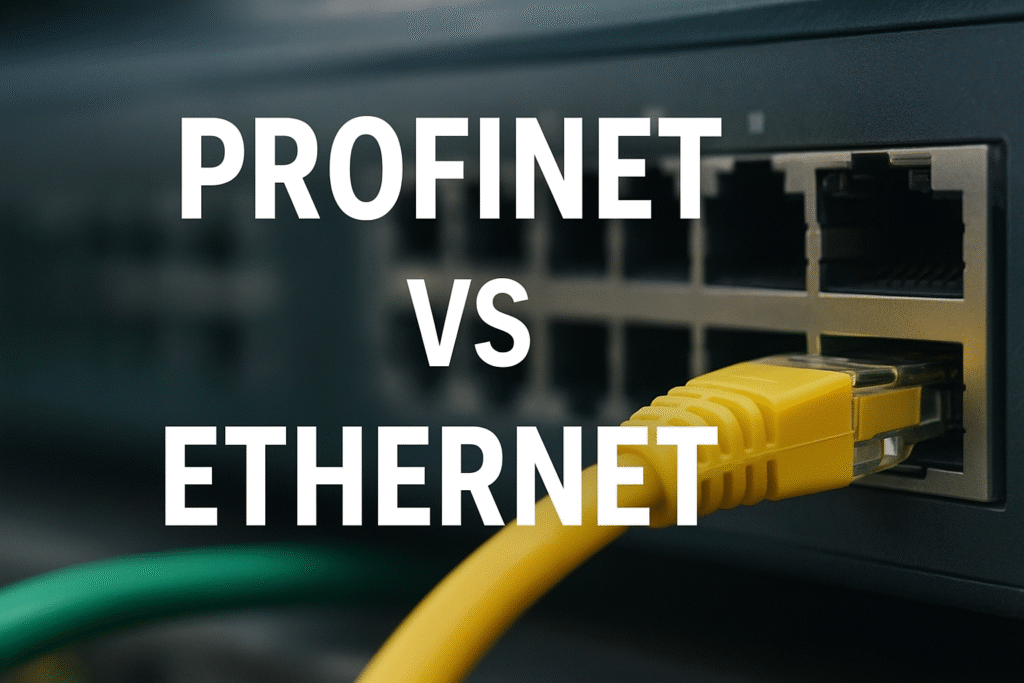Understanding the Basics
When you hear “Ethernet,” you probably think of office networks or home Wi-Fi routers. In reality, Ethernet—standardized by IEEE 802.3—forms the foundation of modern networking with its Layer 1 (physical) and Layer 2 (data link) capabilities. It’s ubiquitous in offices, homes, and many industrial setups for connecting computers, sensors, and devices over fast, affordable cables.
PROFINET, on the other hand, is not a competing technology but a specialized industrial communication protocol built on top of Ethernet. While Ethernet handles the nuts and bolts of sending bits, PROFINET operates at higher layers—especially the application layer (Layer 7)—to deliver deterministic, real-time automation communication required in manufacturing and control systems.
Key Differences
| Aspect | Ethernet (IEEE 802.3) | PROFINET (Industrial Protocol) |
| Definition | Networking standard (physical & data link) | Industrial protocol built atop Ethernet |
| OSI Layers | Layer 1–2 | Layer 7 (application) over Ethernet’s Layers 1–2 |
| Purpose | General networking | Real-time automation, motion control, I/O |
| Determinism | “Best effort”—non-deterministic | Deterministic with RT and IRT modes |
| Device Communication | Any-to-any via TCP/IP | Cyclic/acyclic I/O between controllers and devices |
| Sync & Timing | No real-time timing features | RT, IRT, sync for precise automation |
| Diagnostics | Basic link monitoring | Built-in diagnostics, alarms, advanced system monitoring |
| Environment | Offices, homes, some industry | Rugged, harsh industrial environments |
| Scalability | From small to massive networks | Tailored for scalable automation systems |
Ethernet is ideal for file transfers and general communication, whereas PROFINET adds structure and precision for industrial hardware control.
How They Work Together
PROFINET Runs on Ethernet
PROFINET uses standard Ethernet hardware—like Cat5e/Cat6 cables, industrial switches, and ports—as its physical backbone. You still see the same cables and connectors in factories, but PROFINET brings real-time automation benefits on top of this base.
Office vs. Industrial Use
Ethernet is perfect for standard IT tasks like email, file sharing, and video. PROFINET, however, fills the gap of automation-grade timing and control, where delays or data loss can cause costly downtime.
Coexistence in Unified Networks
In modern industrial setups, regular IT traffic and PROFINET automation traffic can coexist over the same Ethernet infrastructure. PROFINET handles control loops and I/O, while TCP/IP manages diagnostics, configuration, HMI access, and ERP/MES integration.
Real-Time Performance
Standard Ethernet
High bandwidth (ranging from 1 Mbps to 400 Gbps), but relies on “best effort” delivery. There’s no timing guarantee, making it unsuitable for real-time control.
PROFINET’s Real-Time Evolution
- RT Mode (Real-Time): Bypasses TCP/UDP to transfer cyclic data efficiently, achieving cycle times under 1 ms.
- IRT Mode (Isochronous Real-Time): Prioritizes network traffic with reserved bandwidth and traffic shaping to achieve microsecond-level timing—critical for high-speed motion control and robotics.
This ensures deterministic control that standard Ethernet cannot match. PROFINET—especially with IRT—enables precise coordination across robotic arms, conveyors, or CNC.
When to Use PROFINET vs Ethernet
Choose PROFINET when:
- You need deterministic real-time communication (like motion control or robotics).
- You’re working in industrial environments with temperature extremes, vibration, or EMI.
- You need detailed device diagnostics and reduced maintenance.
- You plan to implement IT/OT convergence with coexistence of command and information systems.
Stick with Standard Ethernet when:
- The data tasks are general in nature (email, web streaming, IT setups).
- Timing isn’t critical.
- You’re setting up simple networks with legacy IT workflows.
Conclusion
Ethernet is the backbone of all networked systems—simple, ubiquitous, and capable. But when precision and timing matter, especially in automation, PROFINET transforms Ethernet into a real-time, industrial-grade communication platform.
- Ethernet handles documents, emails, and general connectivity.
- PROFINET manages motion control, deterministic communication, and automation integrity—all running on the same cables.








